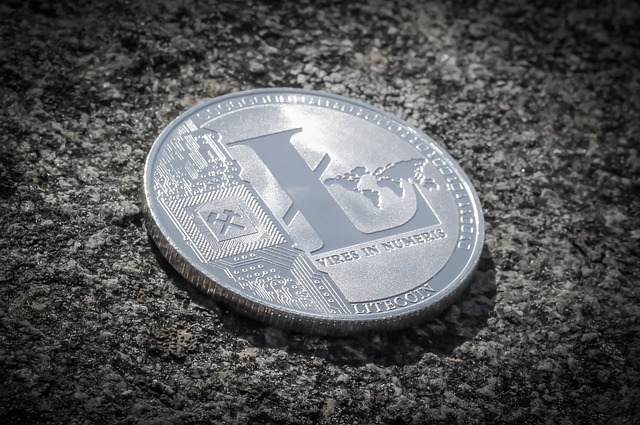Litecoin mining, powered by proof-of-work and ASIC (Application-Specific Integrated Circuit) technology, is crucial for the Litecoin blockchain's security and transaction verification. The shift from general computers to specialized ASIC miners has significantly enhanced network efficiency while increasing competition among miners. This evolution offers higher hash rates, reduced energy consumption, and improved sustainability, making Litecoin mining a more viable option in a competitive and regulated market. With ongoing technological advancements, Litecoin is poised to maintain its position as a leading alternative cryptocurrency with a balanced approach to performance and environmental impact.
In the ever-evolving landscape of cryptocurrency, Litecoin (LTC) remains a prominent player. This article delves into the latest advancements in Litecoin mining, focusing on innovations that drive efficiency and sustainability. We explore the rise of Application-Specific Integrated Circuits (ASICs) and their impact on the network’s security. Furthermore, we discuss energy consumption, highlighting efforts to make Litecoin mining more eco-friendly. Finally, we gaze into the future, examining advanced technologies poised to revolutionize LTC mining practices.
- Understanding Litecoin Mining: A Brief Overview
- The Rise of ASIC Miners in the Litecoin Network
- Innovations Driving Efficiency in Litecoin Mining
- Energy Consumption and Sustainability in Litecoin Mining
- Future Prospects: Advanced Technologies for Litecoin Mining
Understanding Litecoin Mining: A Brief Overview

Litecoin mining, like Bitcoin mining, is the process by which new Litecoin (LTC) are created and transactions are verified on the Litecoin blockchain. It involves solving complex mathematical problems using powerful computers, known as miners. These miners compete to solve these puzzles first, a process called proof-of-work. Once a miner solves the puzzle, they are rewarded with newly minted Litecoin and transaction fees.
The Litecoin network is designed to be more energy-efficient than Bitcoin, which has led to innovations in mining technology. While early Litecoin mining could be done with regular computers or even CPUs and GPUs, the increasing complexity of the problems has made specialized ASIC (Application-Specific Integrated Circuit) miners almost exclusively used today. These ASICs are highly efficient and powerful, enabling miners to process transactions faster and more cost-effectively.
The Rise of ASIC Miners in the Litecoin Network

The evolution of Litecoin mining has witnessed a significant shift towards Application-Specific Integrated Circuits (ASICs). These specialized devices have become the backbone of the Litecoin network, driven by their immense computational power and efficiency. ASIC miners are designed to solve complex mathematical algorithms at an unprecedented speed, making them highly effective in securing the network and processing transactions.
The rise of ASIC miners has revolutionized the mining landscape for Litecoin. They offer a substantial advantage over traditional CPUs and GPUs, providing faster hash rates and lower energy consumption. This innovation has led to increased competition among miners, fostering a more robust and decentralized network. With their advanced capabilities, ASIC miners contribute to the overall security and stability of the Litecoin ecosystem, solidifying their role as key players in the digital currency’s future.
Innovations Driving Efficiency in Litecoin Mining

The latest innovations in Litecoin mining have brought about significant advancements in efficiency, driven by the ever-evolving technology and the competitive nature of the cryptocurrency space. One of the key factors contributing to this is the development of Application-Specific Integrated Circuits (ASICs). ASIC miners are specialized devices designed explicitly for solving complex mathematical problems required to mine Litecoin blocks, offering a substantial performance boost over general-purpose CPUs or GPUs.
These advanced circuits allow for faster processing of transactions and block solutions, reducing the time and energy required for mining. Additionally, ongoing research focuses on improving energy efficiency, a critical aspect given the environmental concerns surrounding cryptocurrency mining. Newer ASIC designs incorporate power-saving features, optimized algorithms, and innovative cooling techniques to minimize energy consumption while maintaining high hashing rates. This trend towards energy-efficient mining is not only beneficial for the Litecoin network’s sustainability but also positions miners to adapt to changing regulatory landscapes regarding energy usage in the digital currency industry.
Energy Consumption and Sustainability in Litecoin Mining

Litecoin mining, like its Bitcoin counterpart, has faced increasing scrutiny regarding its energy consumption and environmental impact. The process demands substantial computational power, leading to high electricity usage. This has prompted discussions on sustainability within the cryptocurrency community. With growing concerns about climate change, there is a pressing need for more energy-efficient mining practices.
Innovations in ASIC technology have played a significant role in this regard. Advanced Application-Specific Integrated Circuits (ASICs) are designed specifically for Litecoin mining, offering improved efficiency and reduced power consumption compared to older models. This shift towards specialized hardware allows miners to optimize their operations while minimizing energy wastage. As the litecoin network evolves, further emphasis on sustainable practices and technology advancements will be crucial in ensuring the long-term viability of this digital currency.
Future Prospects: Advanced Technologies for Litecoin Mining

The future of Litecoin mining looks promising with advancements in technology promising greater efficiency and profitability. As ASICs continue to evolve, they become more powerful yet energy-efficient, making them a key component in the litecoin mining landscape. These specialized chips are designed specifically for blockchain computations, offering significant speedups compared to general-purpose CPUs or GPUs.
Looking ahead, the integration of new technologies such as improved algorithms and cloud mining solutions could further democratize litecoin mining. Advanced cooling systems and optimized hardware configurations will play a crucial role in maximizing hash rates while minimizing energy consumption. This balance between performance and sustainability is essential for the long-term viability of litecoin mining, ensuring its place as a leading alternative cryptocurrency.
Litecoin mining has witnessed significant advancements, driven by innovations in technology and a relentless pursuit of energy efficiency. The integration of Application-Specific Integrated Circuits (ASICs) has revolutionized mining operations, increasing computational power while simultaneously reducing energy consumption. As the Litecoin network continues to evolve, advanced technologies promise even greater efficiency, making it an exciting time for miners and enthusiasts alike. By embracing these innovations, the Litecoin ecosystem can navigate towards a more sustainable future, ensuring its longevity in the ever-changing digital landscape.





Leave a Reply